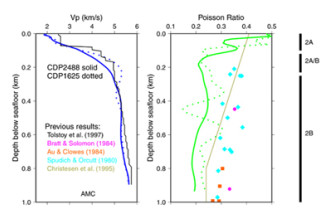Upper Oceanic Crustal Structure

We performed Full waveform inversion on two-ship, wide-aperture multi-channel seismic reflection data collected along the southern East Pacific Rise. The analysis revealed and exploited converted shear waves not previously seen in the data. From the P- and S-wave velocity structure obtained we were able to compute Poisson's Ratio, an elastic parameter: the ratio of transverse contractional strain to longitudinal extensional strain (or in other words, a measure of the degree to which a material expands outwards when squeezed). In a mid-ocean ridge setting the Poisson Ratio structure gives insight into the porosity and crack distribution of the young oceanic crust. We found that the porosity is in excess of 30% in the uppermost layer (2A, the extruded pillow lavas) but reduces to 6-7% across the 2A/2B transition where the extruded pillow basalts are replayed by induced dykes (Fig.1). These results have important implications for the lithostratigraphy of young oceanic crust and hydrothermal circulation.
Publications
- "Poisson´s ratio structure of young oceanic crust" (1998) J S Collier, S.C. Singh. J. Geophys. Res., Vol.103, No.B9, pp.20981-20996 PDF
- "Seismic evidence for a hydrothermal layer above the solid roof of the axial magma chamber" (1999) S.C. Singh, J S Collier, A.J. Harding, G.M. Kent, J.A. Orcutt. Geology, Vol.27, No.3, pp.219-222 PDF
People
- Jenny Collier
- Satish Singh (now at IPG, Paris)